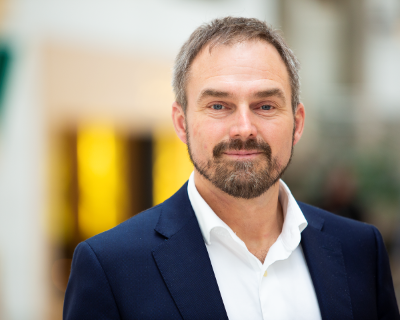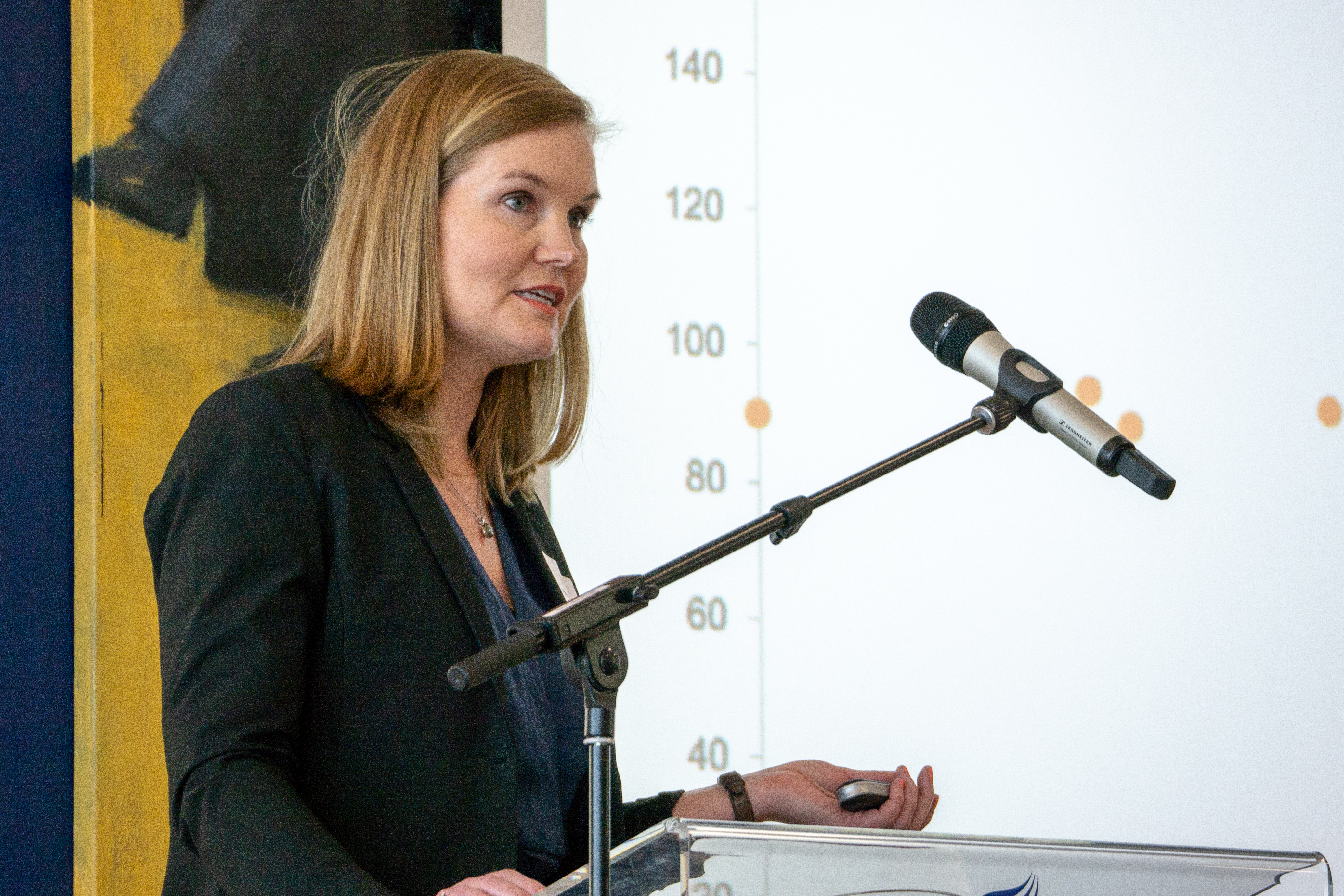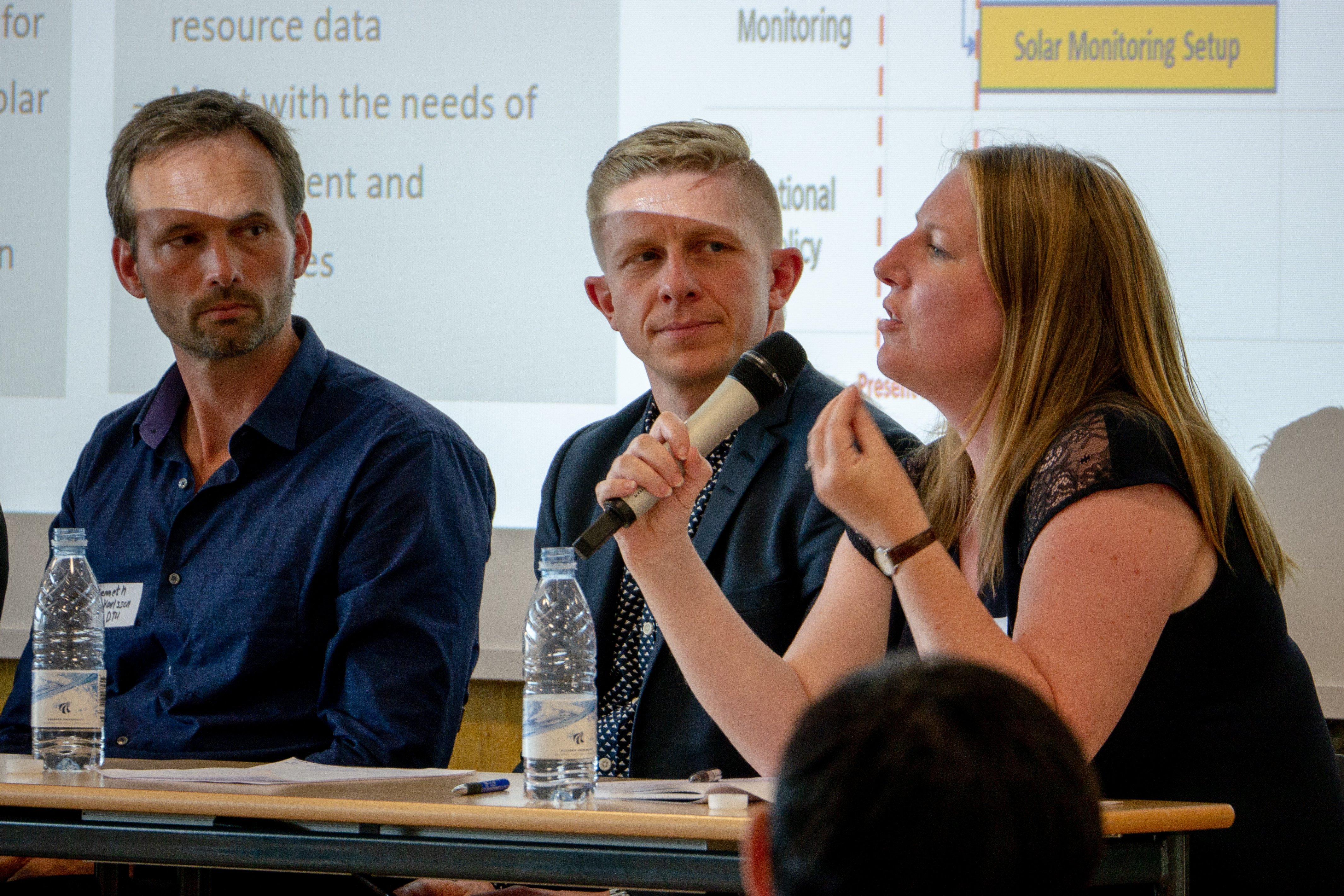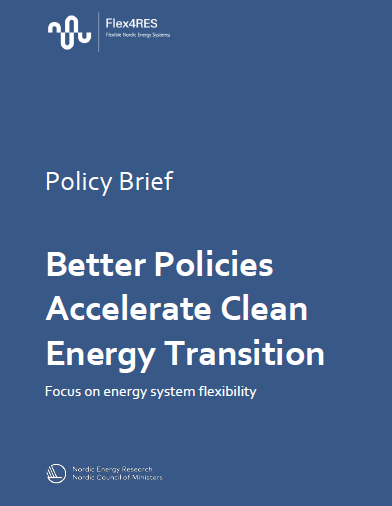Within Flex4RES the following papers are available:
33 published journal articles and book chapters,
22 peer reviewed, published conference papers,
11 reports,
15 forthcoming journal articles under review
on subjects related to the transition to flexible, decarbonised energy systems based increasingly on variable renewables. If you do not have direct access to the articles, please do not hesitate to contact the authors that would be pleased to send you a copy.
Reports
K. Skytte, C. Bergaentzlé, F. Fausto, P.A. Gunkel, Flexible Nordic Energy Systems. Summary Report, 2019. 120 p. Nordic Energy Research, https://www.nordicenergy.org/article/act-fast-and-nordic-while-paving-the-way-for-carbon-neutrality/ ISBN: 978-87-93458-65-9
Bergaentzlé, L. R. Boscán Flores, K. Skytte, E. R. Soysal, and O. J. Olsen, Framework conditions for flexibility in the electricity sector in the Nordic and Baltic Countries. 2016. ISBN: 978-87-93458-46-8
Blom, and L. Söder. Including Hydropower in Large Scale Power System Models. Available from http://kth.diva-portal.org/smash/record.jsf?pid=diva2%3A1320598&dswid=-4766
R. Boscán Flores et al., Framework conditions for flexibility in the Gas–Electricity interface of Nordic and Baltic countries: A focus on Power-to-Gas (P2G). 2017. ISBN: 978-87-93458-50-5 https://www.nordicenergy.org/publications/framework-conditions-for-flexibility-in-the-gas-electricity-interface-of-nordic-and-baltic-countries/
Crosara, E. Tomasson, and L. Söder, Generation Adequacy in the Nordic and Baltic Region: Case Studies from 2020 to 2050. KTH, 2019. Available from http://kth.diva-portal.org/smash/record.jsf?pid=diva2%3A1336561&dswid=-9620
Karimi, P. D. Lund, K. Skytte, and C. Bergaentzlé, Better Policies Accelerate Clean Energy Transition. Policy brief – Focus on energy system flexibility. 2018. Available: https://www.nordicenergy.org/article/better-policies-accelerate-clean-energy-transition/ ISBN: 978-87-93458-56-7.
Koivisto, P. Sørensen, P. Maule, E. Nuño, Needs for Flexibility Caused by the Variability and Uncertainty in Wind and Solar Generation in 2020, 2030 and 2050 Scenarios. DTU Wind, 2017.
Møller Sneum, D. Blumberga, J. Katz, and O. J. Olsen, Framework conditions for flexibility in the individual heating-electricity interface. 2017. Available: http://www.nordicenergy.org/publications/framework-conditions-forflexibility-in-the-individual-heating-electricity-interface/ ISBN: 9788793458499
Møller Sneum, E. Sandberg, E. R. Soysal, K. Skytte, and O. J. Olsen, Framework conditions for flexibility in the district heating-electricity interface. 2016. ISBN: 978-87-93458-42-0 https://www.nordicenergy.org/publications/framework-conditions-for-flexibility-in-the-district-heating-electricity-interface/
Skytte, L. Söder, N. Mohammad, Methodology of Determine Flexibility Costs and Potentials and major flexibility potentials in the Nordic and Baltic countries. DTU/KTH, 2018.
Sønderberg Petersen, R. B. Berg, C. Bergaentzlé, S. Bolwig, and K. Skytte, Eds., Smart grid Transitions: System solutions and consumer behaviour. Department of Management Engineering, Technical University of Denmark, 2017. ISBN: 978-87-93458-51-2
Published journal articles & books
Arabzadeh, S. Pilpola, and P. D. Lund, Coupling Variable Renewable Electricity Production to the Heating Sector through Curtailment and Power-to-heat Strategies for Accelerated Emission Reduction, Futur. Cities Environ., vol. 5, no. 1, Jan. 2019. DOI:10.5334/fce.58
Bergaentzlé, I. Græsted Jensen, K. Skytte, and O. J. Olsen, Electricity grid tariffs as a tool for flexible energy systems: A Danish case study, Energy Policy, pp. 12–21, Mar. 2019. DOI:10.1016/j.enpol.2018.11.021
Blumberga, E. Vigants, F. Romagnoli, A. Blumberga, S. N. Kalnins, and I. Veidenbergs, Hybrid System with Biomethanation for Wind Energy Accumulation in the Baltic Countries, Energy Procedia, vol. 75, pp. 754–759, Aug. 2015. Available: https://www.sciencedirect.com/science/article/pii/S1876610215012758 DOI:10.1016/J.EGYPRO.2015.07.507
Bolwig et al., Review of modelling energy transitions pathways with application to energy system flexibility, Renewable and Sustainable Energy Reviews. Elsevier Ltd, pp. 440–452, 01-Mar-2019. DOI:10.1016/j.rser.2018.11.019
Bramstoft and K. Skytte, Decarbonizing Sweden’s energy and transportation system by 2050, International Journal of Sustainable Energy Planning and Management, vol. 14, p. 3-20, 2017. DOI:10.5278/ijsepm.2017.14.2
Ekström, M. Koivisto, I. Mellin, R. J. Millar, and M. Lehtonen, A statistical modeling methodology for long-term wind generation and power ramp simulations in new generation locations, Energies, vol. 11, no. 9, Sep. 2018. DOI:10.3390/en11092442
Ekström, M. Koivisto, I. Mellin, R. J. Millar, and M. Lehtonen, A Statistical Model for Hourly Large-Scale Wind and Photovoltaic Generation in New Locations, IEEE Trans. Sustain. Energy, vol. 8, no. 4, pp. 1383–1393, Oct. 2017. DOI:10.1109/TSTE.2017.2682338
Gravelsins et al., Modelling energy production flexibility: System dynamics approach, in Energy Procedia, 2018, vol. 147, pp. 503–509. DOI:10.1016/j.egypro.2018.07.060
Herre, T. Matusevičius, J. Olauson, L. Söder, Exploring Wind Power Prognosis Data on Nord Pool: The Case of Sweden and Denmark, IET Renewable Power Generation(2019), 13 (5):690.
Khabdullin, Z. Khabdullina, A. Khabdullin, G. Khabdullina, D. Lauka, and D. Blumberga, Analysis of Industrial Electricity Consumption Flexibility. Assessment of Saving Potential in Latvia and Kazakhstan, in Energy Procedia, 2017, vol. 113, pp. 450–453. DOI:10.1016/j.egypro.2017.04.037
Khabdullin, Z. Khabdullina, G. Khabdullina, D. Lauka, and D. Blumberga, Demand response analysis methodology in district heating system, in Energy Procedia, 2017, vol. 128, pp. 539–543. DOI:10.1016/j.egypro.2017.09.004
G. Kirkerud, T. F. Bolkesjø, and E. Trømborg, Power-to-heat as a flexibility measure for integration of renewable energy, Energy, vol. 128, pp. 776–784, 2017. DOI:10.1016/j.energy.2017.03.153
G. Kirkerud, E. Trømborg, and T. F. Bolkesjø, Impacts of electricity grid tariffs on flexible use of electricity to heat generation, Energy, vol. 115, pp. 1679–1687, Nov. 2016. DOI:10.1016/j.energy.2016.06.147
Koivisto et al., Using time series simulation tools for assessing the effects of variable renewable energy generation on power and energy systems, Wiley Interdisciplinary Reviews: Energy and Environment, vol. 8, no. 3. John Wiley and Sons Ltd, 01-May-2019. DOI:10.1002/wene.329
Møller Sneum and E. Sandberg, Economic incentives for flexible district heating in the Nordic countries, Int. J. Sustain. Energy Plan. Manag., vol. 16, pp. 27–44, May 2018. DOI:10.5278/ijsepm.2018.16.3
Møller Sneum, E. Sandberg, H. Koduvere, O. J. Olsen, and D. Blumberga, Policy incentives for flexible district heating in the Baltic countries, Util. Policy, vol. 51, pp. 61–72, Apr. 2018. DOI:10.1016/j.jup.2018.02.001
Nuno, M. Koivisto, N. Cutululis, and P. Sorensen, On the Simulation of Aggregated Solar PV Forecast Errors, IEEE Trans. Sustain. Energy, vol. 9, no. 4, pp. 1889–1898, Oct. 2018. DOI:10.1109/TSTE.2018.2818727
Pilpola, P.D. Lund, Different flexibility options for better system integration of wind power, Energy Strategy Reviews 26 (2019). DOI: 10.1016/j.esr.2019.100368
Roos and T. F. Bolkesjø, Value of demand flexibility on spot and reserve electricity markets in future power system with increased shares of variable renewable energy, Energy, vol. 144, pp. 207–217, Feb. 2018. DOI:10.1016/j.energy.2017.11.146
Sandberg, J. G. Kirkerud, E. Trømborg, and T. F. Bolkesjø, Energy system impacts of grid tariff structures for flexible power-to-district heat, Energy, pp. 772–781, Feb. 2019. DOI:10.1016/j.energy.2018.11.035
Sandberg, D. Møller Sneum, and E. Trømborg, Framework conditions for Nordic district heating – Similarities and differences, and why Norway sticks out, Energy, 2018. DOI:10.1016/j.energy.2018.01.148
Skytte and L. Bobo, Increasing the value of wind: From passive to active actors in multiple power markets, Wiley Interdisciplinary Reviews: Energy and Environment, vol. 8, no. 3. John Wiley and Sons Ltd, 01-May-2019. DOI:10.1002/wene.328
Skytte and R. Bramstoft, Decarbonising the finnish transport sector by 2050—Electricity or biofuels? in Green Energy and Technology, no. 9783319636115, Springer Verlag, 2018, pp. 3–22. DOI:10.1007/978-3-319-63612-2_1
Skytte and P. E. Grohnheit, Market prices in a power market with more than 50% wind power, in Studies in Systems, Decision and Control, vol. 144, Springer International Publishing, 2018, pp. 81–94. DOI:10.1007/978-3-319-74263-2_4
Skytte, O. J. Olsen, E. R. Soysal, and D. Møller Sneum, Barriers for district heating as a source of flexibility for the electricity system, J. Energy Mark., vol. 10, no. 2, pp. 41–59, 2017. DOI:10.21314/JEM.2017.161
Skytte, A. Pizarro, and K. B. Karlsson, Use of electric vehicles or hydrogen in the Danish transport sector in 2050?, Wiley Interdisciplinary Reviews: Energy and Environment, vol. 6, no. 1. John Wiley and Sons Ltd, 01-Jan-2017. DOI:10.1002/wene.233
Soloha, I. Pakere, and D. Blumberga, Saules enerģijas izmantošana centralizētajā siltumapgādes sistēmā. Gadījuma izpēte Latvijā, pp. 100–118.
Söder, Requirements for Strategic Reserves in a Liberalized Market with Wind Power, in Electricity Markets, Renewable Generation and Software Agents: Traditional and Emerging Market Designs, Springer, Cham, 2018, pp. 165–185. Available: http://link.springer.com/10.1007/978-3-319-74263-2_7 DOI:10.1007/978-3-319-74263-2_7
Söder et al., A review of demand side flexibility potential in Northern Europe, Renewable and Sustainable Energy Reviews, vol. 91. Elsevier Ltd, pp. 654–664, 01-Aug-2018. DOI:10.1016/j.rser.2018.03.104
Tomasson and L. Soder, Generation Adequacy Analysis of Multi-Area Power Systems with a High Share of Wind Power, IEEE Trans. Power Syst., vol. 33, no. 4, pp. 3854–3862, Jul. 2018. DOI:10.1109/TPWRS.2017.2769840
Trømborg, M. Havskjold, T. F. Bolkesjø, J. G. Kirkerud, and Å. G. Tveten, Flexible use of electricity in heat-only district heating plants, Int. J. Sustain. Energy Plan. Manag., vol. 12, pp. 29–46, Mar. 2017. Available: https://journals.aau.dk/index.php/sepm/article/view/1632 DOI:10.5278/ijsepm.2017.12.4
Å. G. Tveten, T. F. Bolkesjø, and I. Ilieva, Increased demand-side flexibility: market effects and impacts on variable renewable energy integration, Int. J. Sustain. Energy Plan. Manag., vol. 11, pp. 33–50, Oct. 2016. Available: https://journals.aau.dk/index.php/sepm/article/view/1419 DOI:10.5278/ijsepm.2016.11.4
Wiese et al., Balmorel open source energy system model, Energy Strateg. Rev., vol. 20, pp. 26–34, Apr. 2018. DOI:10.1016/j.esr.2018.01.003
Forthcoming (by August 2019) peer-reviewed articles
Bazbauers, Power sector flexibility through power-to-heat and power-to-gas application, Submitted for publication.
Bergaentzlé, K. Skytte, and P. A. Gunkel, Comparative analysis of cross-border and cross-sector approaches for flexibility in the Nordic countries, Submitted for publication.
Bolwig et al., Transition pathways to a flexible and carbon-neutral energy system in the Nordic-Baltic region: Coupling techno-economic modelling and socio-technical analyses, Submitted for publication.
Y.-K. Chen, H. Koduvere, P.A. Gunkel, J.G. Kirkerud, K. Skytte, H. Ravn, T.F. Bolkesjø The role of cross-border power transmission in a renewable-rich power system – a model analysis for Northwestern Europe, Submitted for publication.
Y.-K. Chen, A. Hexeberg, K.E. Rosendahl, T.F. Bolkesjø, Review on long-term trends of North-West European power market. Submitted for publication.
Fausto and K. Skytte, Power Purchase Agreements and the Energy Only Market: A Hybrid Design for Future Decarbonized Power Markets, Submitted for publication.
Graested Jensen, F. Wiese, R. Bramstoft, and M. Münster, Potential role of renewable gas in the transition of electricity and district heating systems, Submitted for publication.
A. Gunkel, H. Ravn, S. Petrovic, F. Fausto, H. Koduvere, and J. G. Kirkerud, Modelling transmission systems in energy system analysis: a comparative study, Submitted for publication.
Jasiünas, J. Mikkola, P.D. Lund, Review on energy system resilience. Submitted for publication.
G. Kirkerud, N. O. Nagel, and T. F. Bolkesjø, The role of demand response in the future renewable Northern European energy system, Submitted for publication.
Koduvere, S. Buchholz, and H. Ravn, Constructing aggregated time series data for energy system model analyses, Submitted for publication.
D. Lund, V. Arabzadeh, J. Mikkola, and J. Jasiunas, Deep decarbonization of urban energy systems through renewable energy and sector-coupling flexibility strategies, Submitted for publication.
D. Lund et al., Pathway analysis of a zero-emission transition in the Nordic-Baltic region, Submitted for publication.
Skytte, C. Bergaentzlé, and O. J. Olsen, Grid tariffs that facilitate flexible use of power-to-heat., Submitted for publication.
Sorknæs, H. Lund, I.R. Skov, S. Djørup, K. Skytte, P.E. Morthorst, Smart Energy Markets – future electricity, gas and heating markets. Submitted for publication.
Published conference articles
Bergaentzlé, K. Skytte, J-G. Kirkerud, and O-J. Olsen, Electrification and Interconnections for Flexibility: A Comparative Analysis, in 2019 16th International Conference on the European Energy Market (EEM). IEEE Xplore
Bergaentzlé, K. Skytte, E. R. Soysal, L. R. Boscán Flores, and O. J. Olsen, Regulatory barriers for activating flexibility in the Nordic-Baltic electricity market, in 2017 14th International Conference on the European Energy Market (EEM), 2017, pp. 1–6. DOI:10.1109/EEM.2017.7981948 ISBN: 978-1-5090-5499-2
F. Bolkesjø, J. G. Kirkerud, and E. Trømborg, Power market impacts of increased use of electricity in the heating sector, in 2017 14th International Conference on the European Energy Market (EEM), 2017, pp. 1–6. DOI:10.1109/EEM.2017.7981955 ISBN: 978-1-5090-5499-2
R. Boscán Flores, K. Skytte, and E. R. Soysal, Flexibility-friendly support policies: A Nordic and Baltic perspective, in 2017 14th International Conference on the European Energy Market (EEM), 2017, pp. 1–7. DOI:10.1109/EEM.2017.7981856 ISBN: 978-1-5090-5499-2
Crosara, E. Tómasson and L. Söder, Generation Adequacy in the Nordic and Baltic Area: The Potential of Flexible Residential Electric Heating, 2019 IEEE PES Innovative Smart Grid Technologies Europe (ISGT-Europe)
J. Fausto, P. A. Gunkel, K. Skytte, C. Bergaentzlé, and R. McKenna, Designing Taxes and Tariffs for Electricity Systems with Complex Flexible Actors, in 2019 16th International Conference on the European Energy Market (EEM), 2019
Gea-Bermúdez, L. Pade, A. Papakonstantinou, M Koivisto, North Sea Offshore grid – effects of integration towards 2050, in 2018 15th International Conference on the European Energy Market (EEM), 10.1109/EEM.2018.8469945
P.A. Gunkel, F.J. Fausto, K. Skytte, C. Bergaentzlé, The Impact of EV Charging Schemes on the Nordic Energy System, in the 2019 16th International Conference on the European Energy Market (EEM). IEEE Xplore.
Herre, J. Dalton, L. Söder, Optimal Day-Ahead Energy and Reserve Bidding Strategy of a Risk-Averse Electric Vehicle Aggregator in the Nordic Market, 2019 IEEE Milano PowerTech, Year: 2019
Herre and L. Soder, Enhancing market access of demand response through generation forecast updates, in 2017 IEEE Manchester PowerTech, 2017, pp. 1–6. DOI:10.1109/PTC.2017.7981023 ISBN: 978-1-5090-4237-1
Koivisto, N. Cutululis, and J. Ekström, Minimizing Variance in Variable Renewable Energy Generation in Northern Europe, in 2018 IEEE International Conference on Probabilistic Methods Applied to Power Systems (PMAPS), 2018, pp. 1–6. DOI:10.1109/PMAPS.2018.8440369 ISBN: 978-1-5386-3596-4
Koivisto, P. Maule, N. Cutululis, and P. Sørensen, Effects of Wind Power Technology Development on Large-scale VRE Generation Variability, in 13th IEEE PES PowerTech Conference, Milan, Italy, June 2019.
Koivisto, P. Maule, E. Nuño, P. Sørensen, and N. Cutululis, Statistical Analysis of Offshore Wind and other VRE Generation to Estimate the Variability in Future Residual Load, in Journal of Physics: Conference Series, 2018, vol. 1104, no. 1. DOI:10.1088/1742-6596/1104/1/012011
Koivisto, P. Sørensen, and J. Gea-Bermúdez, North Sea Offshore Grid Development: Combined Optimization of Grid and Generation Investments Towards 2050, 17th Int. Wind Integr. Work., no. October, 2018.
Nuño, M. Koivisto, N. Cutululis, and P. Sorensen, Simulation of regional day-ahead PV power forecast scenarios, in 2017 IEEE Manchester PowerTech, 2017, pp. 1–6. / DOI:10.1109/PTC.2017.7981155 ISBN: 978-1-5090-4237-1
Risberg and L. Soder, Hydro power equivalents of complex river systems, in 2017 IEEE Manchester PowerTech, 2017, pp. 1–6. DOI:10.1109/PTC.2017.7981057 ISBN: 978-1-5090-4237-1
Skytte, C. Bergaentzlé, J. K. Sekamane, and J. Katz, Flexible electricity markets for a decarbonised energy system, Eurelectric-Florence Sch. Regul. Conf., no. June, pp. 20–26, 2017. DOI:10.2870/420547 ISBN: 9789290845775
Skytte, C. Bergaentzlé, E. R. Soysal, and O. J. Olsen, Design of grid tariffs in electricity systems with variable renewable energy and power to heat, in 2017 14th International Conference on the European Energy Market (EEM), 2017, pp. 1–7. DOI:10.1109/EEM.2017.7981940 ISBN: 978-1-5090-5499-2
Skytte and O. J. Olsen, Regulatory barriers for flexible coupling of the Nordic power and district heating markets, in 2016 13th International Conference on the European Energy Market (EEM), 2016, pp. 1–5. DOI:10.1109/EEM.2016.7521319 ISBN: 978-1-5090-1298-5
R. Soysal, D. Møller Sneum, K. Skytte, O. J. Olsen, and E. Sandberg, Electric Boilers in District Heating Systems: A Comparative Study of the Scandinavian market conditions, Swedish Assoc. Energy Econ. Conf., 2016.
R. Soysal, O. J. Olsen, K. Skytte, and J. K. Sekamane, Intraday market asymmetries — A Nordic example, in 2017 14th International Conference on the European Energy Market (EEM), 2017, pp. 1–6. DOI:10.1109/EEM.2017.7981920 ISBN: 978-1-5090-5499-2
Traber, H. Koduvere, and M. Koivisto, Impacts of offshore grid developments in the North Sea region on market values by 2050: How will offshore wind farms and transmission lines pay?, in 2017 14th International Conference on the European Energy Market (EEM), 2017, pp. 1–6. DOI:10.1109/EEM.2017.7981945 ISBN: 978-1-5090-5499-2
Podcasts
In Energy Policycast, Flex4RES results are disseminated in a straightforward (and geeky) way. With host D. M. Sneum. Available: https://energypolicycast.podbean.com/ or https://www.nordicenergy.org/flagship/flex4res/flex4res-podcasts/
Available episodes:
- Fausto, D.M. Sneum, Power Purchase Agreements – Good for the energy system – and for old ladies.
- Lund, D.M. Sneum, Policies for flexibility: A Flex4RES perspective. What have violins to do with flexibility and sector coupling?
- K. Skytte, D.M. Sneum, The future Nordic energy system. Water as storage and flexibility provider – flushing batteries away.
Other dissemination metrics
Homepage: www.Flex4RES.org
LinkedIn: https://www.linkedin.com/company/
Youtube: https://www.youtube.com/channel/UCF0u__dH3GLV7catlUXuP_Q
Vimeo: https://vimeo.com/user99822174











